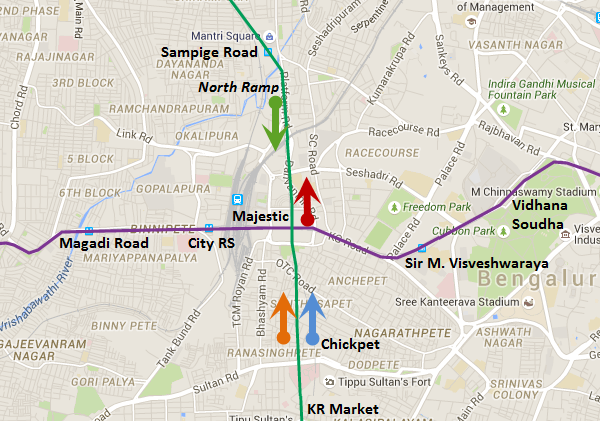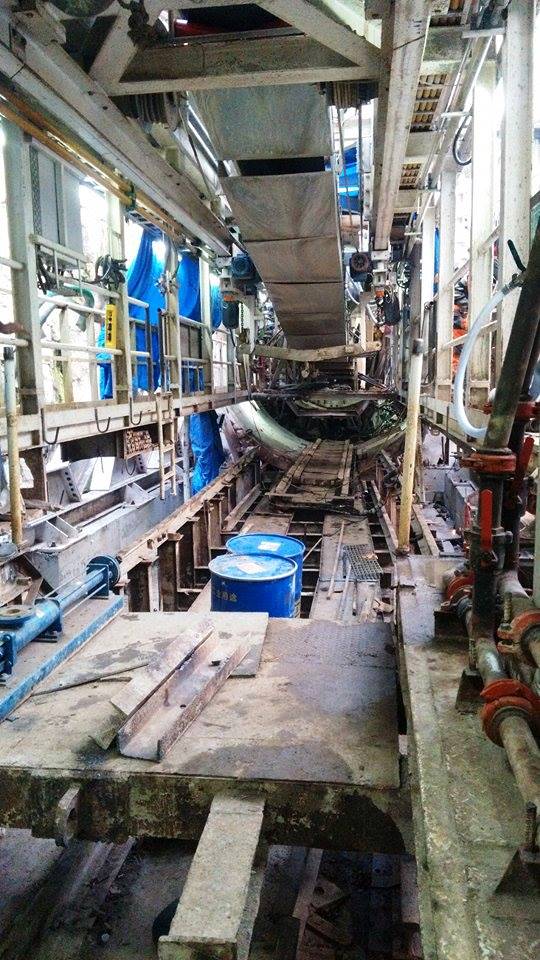Bangalore Metro’s TBM Krishna Finally Starts Tunneling from Chickpet to Majestic
After undergoing maintenance for 112 days, TBM Krishna in Bangalore has finally started tunneling work again! Yesterday afternoon, the TBM began its initial drive on the Green line’s up-line tunnel and placed 3 temporary rings. Actual boring/mining work through Bangalore’s terrain from Chickpet station to Majestic station, a distance of 747m, is expected to begin later today. This is the last tunnel to be bored on the entire system with work also in progress by TBM Godavari (green arrow) and TBM Kaveri (blue arrow) – see the December 2015 Tunneling Update for detailed progress.

Orange Arrow represents TBM Krishna’s location & direction of tunneling

Temporary rings placed by TBM Krishna are visible – Photo Copyright: G Nani Gowda

Inside the backup gantry of TBM Krishna – Photo Copyright: G Nani Gowda
To give a little background – this TBM had made a breakthrough at Chickpet station on August 31 after a slow & tiring journey of 22 months from the KR Market station. The BMRCL’s Managing Director at that time had pledged that the TBM will be relocated to the other end of the shaft and begin tunneling in 45 days after undergoing maintenance. 45 days passed and there was still no sign of the TBM having started. Another 45 days passed in November and there was still no sign. Then earlier this month, the BMRCL’s General Manager of Finance enthusiastically announced on Twitter that the TBM had restarted. After double checking with multiple sources who are closely involved with the project, this turned out to be incorrect much like a lot of the information which has been divulged by the BMRCL so far.
With the TBM now on its merry way, the big question is when it’ll make a breakthrough at Majestic station. To find that out, let’s take a look at the performance of TBM Kaveri which is working on the parallel down-line tunnel. Kaveri was launched in February 2015 and has a little less than 200m out of 744m to go. At the rate at which it is tunneling, Kaveri will reach Majestic only by April/May 2016. With that in mind, TBM Krishna could realistically take anywhere from 12 to 15 months to complete, which places the opening of the Green line’s underground section and the entire Phase 1 project towards the end of 2017.
For more updates on Bangalore’s Metro, check out the Bangalore section of The Metro Rail Guy!
– TMRG




It is a tradey that metro completion of Phase 1 is extended to the year 2017. Metro is sleeping, on the green line they have stopped work on elevated line like Metro Stations. Can be completed all works till completion of underground work. Even they think of starting from National college to Puttnehalli metro services. Lame excuses should be stopped
Why can’t BMRCL rent 4 more Tunnel Boring Machines and speed up the work? It looks like they didn’t get the highest quality, quickest boring machines the money could buy. By saving money in getting the TBMs, they lost a lot of money in delayed work. Sounds like penny wise, pound foolish to me.
What do you think?
Hi, it’s totally up to the contractor to decide the number of TBMs to be used. The BMRCL can however stipulate the number of new TBMs to be used and their overall type based on the recommendations of the Detailed Project Report. In B’lore, an unknown JV company by the name of Coastal-TTS was awarded the contract based on the lowest bid-price, so the BMRCL effectively got what they were paying for.
As per Wikipedia there are 2 main types of TBMs
1. Hard rock TBM – used for boring tunnels through hard rock such as boulders and mountains
2. Soft ground TBM – used for boring tunnels through soft ground such as tunnels under the river, under the sea, or through geology consisting of sand & gravel
This article –>
tunneltalk.com/Bangalore-Metro-17Mar2014-Final-drive-for-UG2-breaks-through.php
from Tunnel Talk states about the Bangalore Metro,
“The complex geology at tunnel alignment comprises a mix of
a) hard massive granite, at more than 300MPa UCS and few joints or fissures, in the bottom of the face;
b) layers of weathered granite in the centre, with many fresh granite blocks and boulders in the weathered matrix; and
c) residual soils of wet running sands, clays and gravels at the top. ”
In such a case, why did BMRCL choose a soft ground TBM like the Hitachi Zosen slurry type TBM? Isn’t it suitable only for soft ground, as in under the river and under the ocean/sea? As per Wikipedia, slurry type TBMs are NOT EVEN suitable for silts and clays, forget hard rock like granite.
My question is WHY DID BMRCL choose a slurry type TBM when the geology at the tunnel level mainly consists of hard rock? Isn’t the Hitachi Zosen hard rock tunnel boring machine, the right choice? Did they make a mistake in selecting the TBMs which is resulting in multi-year delays? Can they not make amends, if they have made mistakes, and get the right TBMs so that delays can be cut?
Hi, the slurry TBMs used in Bangalore are fine. CEC-CICI, the contractor for the east-west line used just 2 slurry based TBMs called Helen and Margarita to finish the job within the time allocated to them. Their work ethic, documentation and maintenance was top-notch. The main issue with the north-south line is the jugaadu contractor (Coastal-TTS JV) who really has no credibility, no evidence of documenting the progress and no proper maintenance schedule. Due to this, TBM Godavari’s cutterhead got damaged and was out of work for more than a year. Similarly Krishna had to stop for long periods of time and eventually took 22 months to finish its last job.
Are BMRCL officials sleeping…..
why can’t they kick such contractors and assign the work to other?
or
Are BMRCL officials involved in some Bribery?
looks like this is the reason why “Sreedharan (who is also principal advisor for Delhi Metro Rail Corporation Limited (DMRC)) said “false ego and prestige of BMRCL heads has caused the delay in execution of the project.”
Kicking a contractor out for tardy work can result in long delays. Chennai Metro has seen that in 2 stretches (Airport and UAA02/03), so it’s easier for the metro org to always work it out with the contractor & hire some experts/add’l contractor to finish the job. In Bangalore, the BMRCL had to request the east-west contractor to deploy one of their TBMs (Margarita) to complete a tunnel for the north-south contractor.